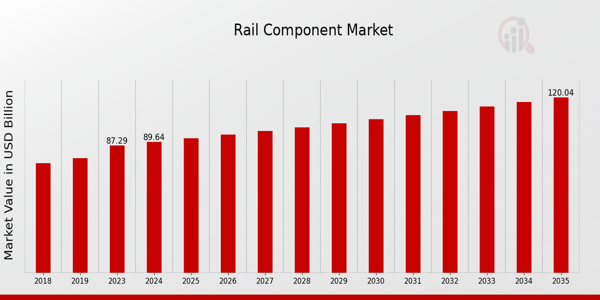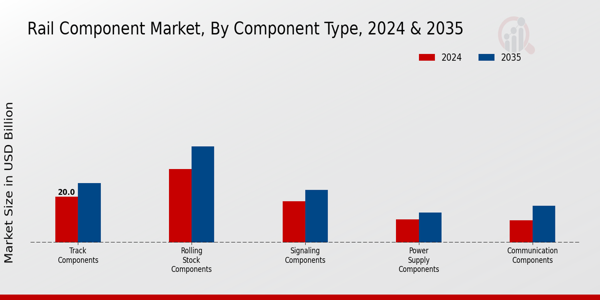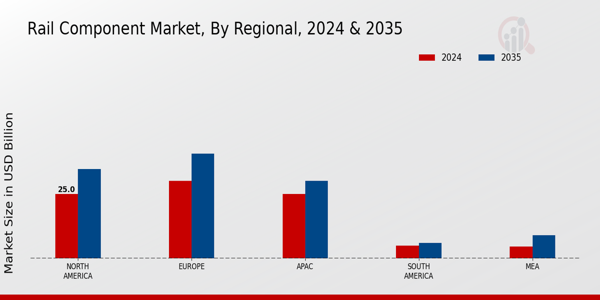Global Rail Component Market Overview:
As per MRFR analysis, the Rail Component Market Size was estimated at 87.29 (USD Billion) in 2023. The Rail Component Market Industry is expected to grow from 89.64 (USD Billion) in 2024 to 120.0 (USD Billion) by 2035. The Rail Component Market CAGR (growth rate) is expected to be around 2.69% during the forecast period (2025 - 2035).
Key Rail Component Market Trends Highlighted
The Rail Component Market is growing significantly as a result of increased spending in railway systems and the need for greener modes of transport. Rail systems which are dependable and efficient are in high demand, therefore, manufacturers have to constantly work to upgrade their products. Expansion of high-speed rail systems along with the growing focus on safety and modernization will promote the constant demand for rail component parts. An increase in the degree of urbanization also increases the demand for commuter rail services which creates an opportunity for new advancements in rail technology.
The supply side of the industry can take advantage of the gaps in the rail component market.
The move towards electric propulsion systems and use of environmentally sustainable technological approach increases the investment in green rail component parts. Large scale vertically integrated projects that modernize rail systems can be accomplished through public-private partnerships. Furthermore, increased investment in smart rail systems create new possibilities for incorporating modern information technologies into rail components to make system operations more effective while improving service delivery to the passengers. Recently, strivings to increase the efficiency of the component partshave resulted in greater use of light weight materials in construction.
The adoption of automation and IoT technologies within rail operations is creating more adavanced and interlinked systems. There is increasing adoption of digital technologies that enhance management of assets as well as predictive maintenance, which minimizes idle time. A key concern for many players is sustainability, which drives the innovation of components that are compliant with challenging environmental policies. These trends alongside the changing market will determine the future of rail components and the industry as a whole.

Source: Primary Research, Secondary Research, Market Research Future Database and Analyst Review
Rail Component Market Drivers
Infrastructure Development and Urbanization
The Rail Component Market Industry is witnessing significant growth primarily due to ongoing infrastructure development and increasing urbanization across various regions. As cities expand and populations increase, there is a rising demand for efficient transportation solutions. This trend is particularly prominent in developing countries, where governments are investing heavily in rail networks to improve connectivity and reduce traffic congestion. Enhanced rail infrastructure not only supports daily commutes but also facilitates trade and mobility, thus promoting economic growth. This ongoing urban development drives the need for advanced rail components to ensure safety, reliability, and efficiency in transportation.
Enhanced railway infrastructure leads to higher passenger comfort, capacity, and energy efficiency, ultimately pushing the market for rail components further. Moreover, as urban populations continue to swell, the requirements for rapid transit solutions grow, prompting governments and private entities to focus on expanding and modernizing their rail systems. This creates immense growth opportunities for manufacturers in the Rail Component Market Industry as they cater to the demand for innovative, durable, and high-quality components. Additionally, sustainability initiatives are encouraging investment in rail infrastructures, as rail systems are generally more environmentally friendly compared to road transport.
Producers of rail components must adapt to new technologies, such as electric trains and automated systems, aligning with global sustainability and efficiency goals, thereby carving out niches in this evolving landscape.
Technological Advancements in Rail Systems
Technological advancements mark a crucial driver for the Rail Component Market Industry, as innovation continues to shape train systems and their components. The integration of smart technologies, such as AI and IoT, into railways enables improved operational efficiencies, real-time monitoring, and predictive maintenance. These advancements contribute to overall system reliability and safety, drawing investments from various sectors. As railways evolve, there is an increasing demand for cutting-edge components that can support these technologies, fostering growth in the market.
Government Initiatives and Funding
Government initiatives and funding play a pivotal role in the expansion of the Rail Component Market Industry. Many countries identify rail transport as a sustainable and efficient alternative to traditional road networks. To facilitate this transition, governments around the world are allocating budgetary resources, crafting policies that promote rail transport, and investing in public-private partnerships. These efforts not only enhance existing rail systems but also fuel the demand for new rail components, contributing to significant market growth.
Rail Component Market Segment Insights:
Rail Component Market Component Type Insights
The Rail Component Market demonstrates a diverse segmentation based on component types, which plays a crucial role in the overall industry functionality and growth. In 2024, the market's track components were valued at 20.0 USD Billion, indicating their significance in supporting the railway infrastructure. This segment is expected to reach 26.0 USD Billion by 2035, showcasing considerable growth that reflects the increasing demand for robust and efficient railway systems amid global urbanization trends. Rolling stock components represent another vital area, holding the largest market share at 32.0 USD Billion in 2024.
This valuation underlines the importance of rolling stock in ensuring passenger and freight mobility. By 2035, this segment is projected to grow to 42.0 USD Billion, emphasizing the need for modern, reliable rolling stock systems in a rapidly advancing transportation landscape.
Within the Rail Component Market, signaling components also hold a notable position, with an initial valuation of 18.0 USD Billion in 2024, enhancing safety and operational efficiency across rail networks. Their projected growth to 23.0 USD Billion by 2035 reflects the increasing focus on automated and intelligent signaling systems needed to cope with traffic demands and enhance safety protocols.
Power supply components, valued at 10.0 USD Billion in 2024 and anticipated to reach 13.0 USD Billion by 2035, reveal the critical role electrical supply systems play in sustaining operations, particularly as electrification expands within rail networks, promoting energy efficiency and reducing operational costs.
Communication components are also integral to the market, valued at 9.64 USD Billion in 2024 and expected to rise to 16.0 USD Billion by 2035. The rise of these components signifies the growing need for effective communication technologies that facilitate real-time data exchange between trains, control centers, and maintenance systems, thereby improving overall network efficiency. The steady growth and strategic importance of each component type within the Rail Component Market reflect the industry's trend toward modernization and increased efficiency, driven largely by urbanization, sustainability goals, and advancements in technology.
This dynamic segmentation underscores the market's adaptability and responsiveness to evolving demands in rail transport.

Source: Primary Research, Secondary Research, Market Research Future Database and Analyst Review
Rail Component Market End Use Insights
The Rail Component Market has been segmented significantly by End Use, showcasing the diverse applications of rail components across various sectors. By 2024, the market is expected to be valued at 89.64 USD Billion, reflecting a robust demand driven by increasing urbanization and the need for efficient transport systems. Passenger Rail remains a crucial segment, catering to daily commuters, thereby highlighting its importance in enhancing public transport efficiency. Freight Rail, on the other hand, plays an essential role in logistics and trade, ensuring the smooth transport of goods across regions, which is vital for economic growth.
Light Rail systems are increasingly favored in urban settings for their ability to reduce congestion and provide an eco-friendly transport solution, catering to the growing preference for sustainable transport options. Meanwhile, High-Speed Rail is gaining traction, providing a rapid transit alternative that connects distant cities, thus promoting economic connectivity. The Rail Component Market revenue reflects these trends, highlighting the significant contribution of each area to the overall market dynamics.
Factors in driving growth include advancements in rail technology, government initiatives towards rail infrastructure improvement, and an increasing demand for sustainable transport solutions, making the overall market environment ripe for investment and innovation.
Rail Component Market Material Type Insights
The Rail Component Market is projected to reach a value of 89.64 USD Billion in 2024, showcasing robust growth driven by advancements in technology and increasing investments in rail infrastructure across various regions. Within the Material Type segment, steel remains a critical material due to its strength and durability, making it a dominant choice for various rail components. Aluminum is also gaining traction for its lightweight properties, promoting fuel efficiency and reducing overall operational costs. Composites are emerging as a significant player, offering enhanced performance and resistance to corrosion, which adds longevity to rail components.
Rubber, vital for vibration damping and noise reduction, continues to support rail safety and comfort. Market growth reflects the industry's push towards sustainable materials, supporting eco-friendliness and efficiency in rail systems. These Material Type divisions within the Rail Component Market segmentation highlight the critical factors affecting speed, safety, and cost-efficiency, shaping the industry's future dynamics. Factors such as evolving regulations, environmental considerations, and the demand for high-performance components contribute to the ongoing evolution and transformation of the market landscape, underlining the importance of this sector in global rail transportation.
Rail Component Market Design Type Insights
The Rail Component Market focuses significantly on the Design Type segment, which plays a crucial role in meeting the evolving needs of the rail industry. By 2024, the overall market is expected to be valued at approximately 89.64 billion USD, highlighting the increasing investment in rail infrastructure and components. Within this segment, the Design Type is primarily categorized into Standard Design and Customized Design. Standard Design components are widely used due to their cost-effectiveness and ease of integration with existing systems, which makes them a popular choice among many rail operators.
On the other hand, Customized Design is gaining traction as it allows for tailored solutions that meet specific operational requirements, thus enhancing efficiency and performance. The demand for Customized Design is rising as rail companies seek to optimize operations and ensure safety and reliability, showcasing its importance in addressing unique customer needs. As the Rail Component Market continues to evolve, the market growth driven by these design types plays a vital role in shaping the future of rail transport solutions. Moreover, trends toward sustainability and technological advancements further contribute to the diverse requirements in the rail components sector.
Rail Component Market Regional Insights
The Rail Component Market showcases a diverse landscape across various regions, contributing significantly to its overall revenue. In 2024, North America stands as a dominant force with a valuation of 25.0 USD Billion, expected to grow to 34.5 USD Billion by 2035, reflecting its established rail network and infrastructure investments. Europe follows closely with a market value of 30.0 USD Billion in 2024, projected to rise to 40.5 USD Billion, underlining its robust rail transport systems and emphasis on sustainable mobility solutions.
The APAC region matches North America with a valuation of 25.0 USD Billion in 2024, increasing to 30.0 USD Billion, fueled by rapid urbanization and rising demand for modern rail systems in developing economies.
Meanwhile, South America, although smaller with a 2024 value of 5.0 USD Billion and a forecasted 6.0 USD Billion by 2035, is witnessing increasing investments in rail infrastructure. The MEA region, valued at 4.64 USD Billion in 2024 and expected to reach 9.0 USD Billion, is gradually gaining attention due to its expanding rail network initiatives. Overall, the Rail Component Market industry is shaped by various factors, including regional demand dynamics, infrastructure investments, and government policies fostering growth and development.

Source: Primary Research, Secondary Research, Market Research Future Database and Analyst Review
Rail Component Market Key Players and Competitive Insights:
The Rail Component Market is a dynamic segment influenced by technological innovations, government regulations, and increasing demand for efficient transportation systems. As countries invest in rail infrastructure to enhance mobility and reduce congestion, the competitive landscape for rail components has become increasingly complex. Companies in this market strive to establish a competitive edge through strategic partnerships, mergers and acquisitions, and technological advancements. Continuous efforts to improve product quality and meet safety standards are also paramount, as market players seek to meet the evolving needs of various rail operators.
This growing competition is further fueled by a shift towards sustainable practices, prompting manufacturers to develop eco-friendly components without compromising performance or reliability.
KnorrBremse stands out as a formidable player in the Rail Component Market, recognized for its innovative braking systems and advanced technology solutions. The company has established itself as a leader in developing and manufacturing exceptionally reliable components that cater to both freight and passenger rail systems. Its robust R&D capabilities have allowed KnorrBremse to pioneer state-of-the-art products that enhance operational efficiency and improve safety standards across global rail networks.
Furthermore, KnorrBremse's commitment to sustainability is evidenced by its initiatives aimed at reducing the environmental footprint of rail operations, thus positioning the company favorably in a market that increasingly values green solutions. The firm's extensive experience in collaborating with various rail operators and manufacturers adds to its strengths, ensuring a solid footprint in key markets worldwide.
General Electric has a significant presence in the Rail Component Market, leveraging its vast expertise in power generation and advanced technology to provide a wide array of rail solutions. The company is well-regarded for its robust portfolio of locomotives and associated components that integrate cutting-edge digital technologies, making rail operations more efficient and reliable. General Electric's commitment to innovation is evident in its focus on data-driven solutions that enhance fleet management and predictive maintenance, enabling operators to optimize their rail networks.
The company's strong emphasis on customer support and long-standing relationships with various rail operators contributes to its competitive advantage in the market. Moreover, General Electric actively engages in sustainability initiatives, promoting electric and hybrid solutions in the rail industry, thus ensuring that its offerings resonate well with the growing demand for environmentally friendly transportation alternatives.
Key Companies in the Rail Component Market Include:
- Kawasaki Heavy Industries
Rail Component Market Industry Developments
Recent developments in the Rail Component Market highlight a strong focus on technological advancements and sustainability. KnorrBremse announced the launch of innovative brake solutions aimed at enhancing safety and efficiency in rail operations. General Electric is ramping up its investments in digital rail technologies to improve predictive maintenance. Faiveley Transport has secured contracts for providing advanced climate control systems, indicating a growing demand for passenger comfort. Meanwhile, Wabtec is actively pursuing partnerships to bolster its electric and hybrid train technologies.
CAF recently expanded its presence in Asia with new contracts for rolling stock, reflecting growth in international markets. Bombardier is consolidating its rail division to streamline operations and increase profitability, while Thales has emphasized digital innovation in signaling and safety systems. ABB has been advancing its electrification solutions for railways, aiming for increased efficiency. CRRC Corporation continues to dominate in manufacturing with new high-speed train models. Market valuations are rising as companies like Alstom and Siemens report solid earnings, fueled by increased urbanization and infrastructure investments globally.
Mergers and acquisitions are also on the rise, with significant movements among these companies indicating a dynamic landscape in the rail industry.
Rail Component Market Segmentation Insights
Rail Component Market Component Type Outlook
Rail Component Market End Use Outlook
Rail Component Market Material Type Outlook
Rail Component Market Design Type Outlook
Rail Component Market Regional Outlook
| Attribute/Metric Source: |
Details |
| MARKET SIZE 2023 |
87.29 (USD Billion) |
| MARKET SIZE 2024 |
89.64 (USD Billion) |
| MARKET SIZE 2035 |
120.0 (USD Billion) |
| COMPOUND ANNUAL GROWTH RATE (CAGR) |
2.69% (2025 - 2035) |
| REPORT COVERAGE |
Revenue Forecast, Competitive Landscape, Growth Factors, and Trends |
| BASE YEAR |
2024 |
| MARKET FORECAST PERIOD |
2025 - 2035 |
| HISTORICAL DATA |
2019 - 2024 |
| MARKET FORECAST UNITS |
USD Billion |
| KEY COMPANIES PROFILED |
KnorrBremse, General Electric, Faiveley Transport, Wabtec, CAF, Bombardier, Thales, ABB, CRRC Corporation, Alstom, Hitachi, Amsted Rail, Siemens, Voith, Kawasaki Heavy Industries |
| SEGMENTS COVERED |
Component Type, End Use, Material Type, Design Type, Regional |
| KEY MARKET OPPORTUNITIES |
Technological advancements in rail systems, Expansion of high-speed rail networks, Increasing demand for sustainable transport, Upgrading aging rail infrastructure, Growth in freight rail services |
| KEY MARKET DYNAMICS |
Increasing demand for rail transport, Technological advancements in components, Growing investments in infrastructure, Emphasis on sustainability initiatives, Rising safety and reliability standards |
| COUNTRIES COVERED |
North America, Europe, APAC, South America, MEA |
Frequently Asked Questions (FAQ):
The Rail Component Market is expected to be valued at 89.64 USD Billion in 2024.
By 2035, the Rail Component Market is projected to reach a value of 120.0 USD Billion.
The expected CAGR for the Rail Component Market from 2025 to 2035 is 2.69%.
In 2024, Europe has the largest market share in the Rail Component Market, valued at 30.0 USD Billion.
The market value of North America in 2035 is projected to be 34.5 USD Billion.
Key players in the Rail Component Market include KnorrBremse, General Electric, Faiveley Transport, and Wabtec.
The market size for Track Components in 2024 is expected to be 20.0 USD Billion.
The Rolling Stock Components segment is expected to grow from 32.0 USD Billion in 2024 to 42.0 USD Billion by 2035.
By 2035, the expected market value for Communication Components is 16.0 USD Billion.
The Rail Component Market may face challenges such as regulatory compliance and supply chain disruptions affecting its growth.

















